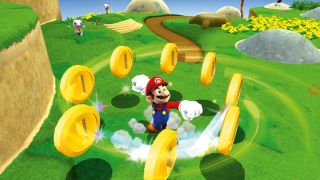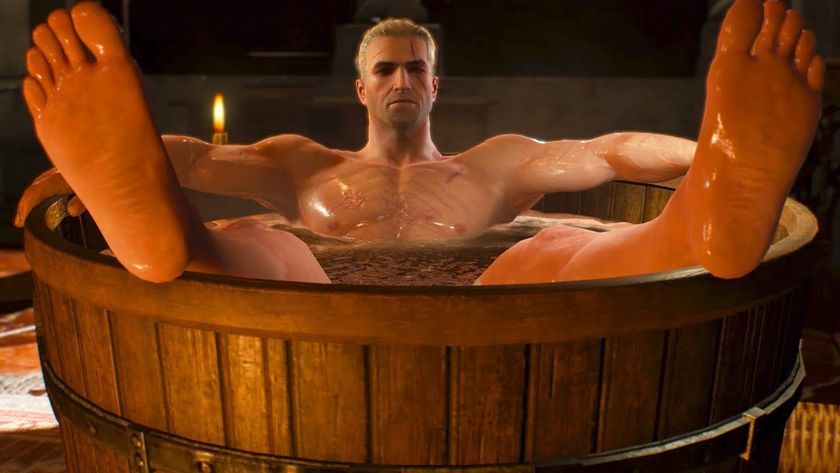Why Nintendos abundant gold coins are also among its most valuable offerings

With the Zelda series increasingly concerned with curation, it’s left to Mario to provide the focal point for pure creativity in Nintendo’s universe. Link’s ever-repeating adventures are never particularly short of invention, but his dungeon masters seem to have trouble letting go, turning even incidental rifts into ongoing lore. Mario, on the other hand, spares relatively little thought for history, and will shred good ideas with no obvious remorse – often after a single outing. Deformable terrain, animal suits, a handful of different approaches to flight: concepts come and go pretty easily in the Mushroom Kingdom, and even returning favourites rarely make it back in without a clever tweak or two.
A few special things remain sacred and consistent, however. One of them is undoubtedly crucial: the plumber’s weight is fixed and constant, rendering his particular sense of heft in the air or on foot unmistakable. The other unchanging element, meanwhile, initially seems pretty trivial compared to that. It’s a token of the most literal kind: Mario’s gold coins.
So why has such a simple, seemingly unimportant, aspect of the grand design endured? After all, collectables can be toxic for any kind of games, but they’re particularly dangerous when combined with platformers. They’re a siren lure towards padding, a temptation to rely on pure endurance exploration and treasure hunts. Mario’s adventures have indulged in their fair share of both activities, of course, yet those unmistakable coins – possibly the most recognisable collectable ever – remain weirdly untarnished by it. Somehow, they’ve retained their value while Sonic The Hedgehog’s tinkling golden rings have become little more than a cold, hard health mechanic, Crash Bandicoot’s apples are all but forgotten, and Banjo-Kazooie’s in-game economy has collapsed into miserable hyperinflation among a shrill muddle of musical notes, puzzle pieces, honeycomb chunks and Mumbo tokens.
Mario’s coins top up his health like Sonic’s rings, and they form part of a complex structure of collectables as they slot in alongside a fluctuating mass of mushrooms, flowers, Shines and Star Bits: as a whole, it almost rivals any of Rare’s excesses. They’ve proved so unnaturally hardy, though, not just because of their cheerily iconic nature or the irresistible urge every player feels to snap them up as quickly as possible. It’s because the reason for snapping them up has been quietly and consistently repurposed over the decades, depending on the needs of the game.
So while gold coins have always been worth grabbing – in fact, it can take a surprising amount of willpower to leave them where they are – they’ve performed a range of different functions. In the original Mario Bros, they were the perfect arcade contrivance: a deadly points-hoarding lure to distract your attention away from enemies. Eugene Jarvis would have been proud. During the side-scrolling years, however, from that very first mystery block in World 1-1 when they rewarded you for the simple act of performing a jump, their mischievous side all but vanished. They were cast, instead, as an indicator of the hidden nature of the Mario games’ secrets: a bribe to punch every brick, climb every vine and test every pipe. They became an invitation to slow down rather than speed up, a reason to explore. They were a reward for replaying the games and even trying to see if you could break them.
Now, as Mario’s latest travels pass through ever-more-complex worlds, as they begin to fiddle with physics and to bend geometry in some distinctly non-Euclidean manners, the gold coins have evolved into an elegant and understated form of guide. Part tutorial, part pathfinder, wherever Mario goes, he follows a bright trail picked out in clusters of spinning coins in order to get there. It’s a helping hand so subtle you’ll barely notice it: the perfect system of waypoint markers to complement the perfect game.
And the most brilliant thing about it is that they’re generally used fairly sparingly. Pathfinding – especially inside complex, gimmick-riddled 3D worlds – remains one of the trickiest of problems to solve. Maps can be hard to read and spoilerish, and they have a nasty habit of breaking up the flow of discovery. Fable II’s breadcrumb trail was perhaps too cute and too intrusive, and it was certainly too unreliable. As for Joanna Dark’s wretched time-delayed disco chevrons, or Isaac Clarke’s hand-mounted laser, they seem like open admissions of design failure, even if they’re gracefully employed. Only Mario’s coins can guide you without patronising you, providing seemingly random knots of gold that allow you to discover the correct path through the most intricate of environments with an ease that can feel spookily similar to intuition.
Sign up to the 12DOVE Newsletter
Weekly digests, tales from the communities you love, and more
Ultimately, then, it all comes down to a flair for adaptation. So much changes: the console, the audience and sometimes even the genre. Yet almost every Mario game – even the sideshows – has made use of those coins, whether they’re providing the magic-potion Easter eggs of Super Mario 2 or the stand-in racing line for the Mario Kart games. Unlike something such as arcade-style scoring, a vestigial tail that is now reserved for the 2D Mushroom Kingdom outings only, Mario’s gold coins are simply too irresistible – and too helpful – to ever cast aside.
Read more from Edge here. Or take advantage of our subscription offers for print and digital editions.
Edge magazine was launched in 1993 with a mission to dig deep into the inner workings of the international videogame industry, quickly building a reputation for next-level analysis, features, interviews and reviews that holds fast nearly 30 years on.
















